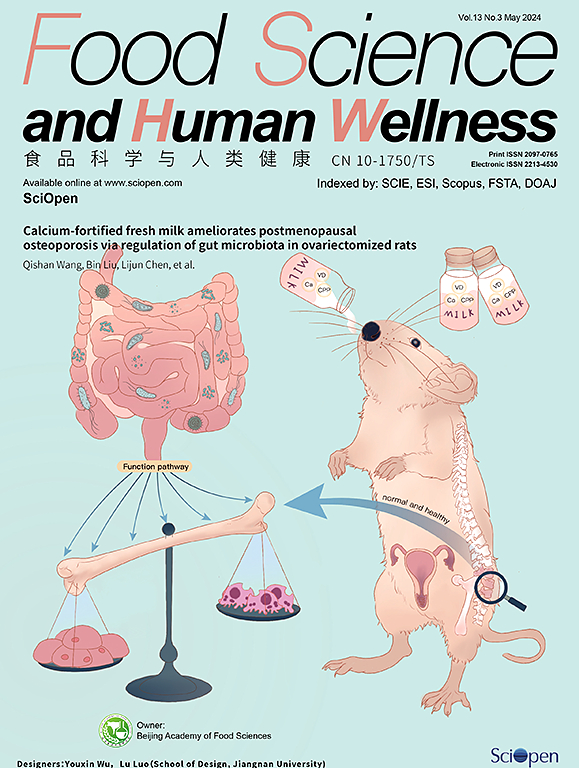The impact of short-term changes in sleeping and eating patterns on glucometabolic health and gut microbiota in healthy young adults: a proof-of-concept controlled feeding study
IF 7.4
1区 农林科学
Q1 FOOD SCIENCE & TECHNOLOGY
引用次数: 0
Abstract
Epidemiological studies showed that night workers are at higher risk of developing chronic metabolic diseases. However, no study has investigated the changes in circadian rhythms caused by a combined effect of sleep and diet in a real-life setting on cardiometabolic health, gut microbiota, and psychological status in healthy people. A 4-week step-wise misaligned-realigned controlled-feeding trial with a 2 × 2 factorial design (sleep and diet) was conducted on healthy young adults. At first, subjects experienced a one-week circadian rhythm misalignment with a high-fat fast-food diet, extended eating window, and delayed sleep schedules, then gradually transited to a complete circadian rhythm realignment with a high-fiber balanced diet, 8-h time-restricted eating, and normal sleep schedules. Circadian rhythm misalignment led to significantly higher levels of fasting glucose and homeostatic model assessment for insulin resistance (HOMA-IR) of subjects compared to baseline and failed to recover to the baseline level in circadian rhythm realignments. Notably, the incremental area under the curve (iAUC) of postprandial glucose decreased with circadian rhythm adjustments as compared to that in circadian rhythm misalignment, suggesting circadian rhythm realignment by sleep or/and diet could partly restore glucose metabolism impaired by a short-term circadian rhythm misalignment. However, circadian rhythm changes did not result in overall perturbations of gut microbiota diversities.
短期改变睡眠和饮食模式对健康年轻人的糖代谢健康和肠道微生物群的影响:概念验证对照喂养研究
流行病学研究表明,夜班工人患慢性代谢性疾病的风险较高。然而,目前还没有研究调查睡眠和饮食在现实生活中对健康人群的心脏代谢健康、肠道微生物群和心理状态的综合影响所引起的昼夜节律变化。采用2 × 2因子设计(睡眠和饮食)对健康年轻人进行了为期4周的逐步错配-重新调整对照喂养试验。首先,受试者经历了为期一周的昼夜节律失调,包括高脂肪快餐饮食、延长进食窗口和延迟睡眠时间表,然后逐渐过渡到完全的昼夜节律调整,包括高纤维均衡饮食、8小时限时进食和正常睡眠时间表。与基线相比,昼夜节律失调导致受试者的空腹血糖水平和胰岛素抵抗的稳态模型评估(HOMA-IR)显著升高,并且在昼夜节律调整中未能恢复到基线水平。值得注意的是,与昼夜节律失调相比,调整昼夜节律后餐后葡萄糖的曲线下增量面积(iAUC)降低,这表明通过睡眠或/和饮食调整昼夜节律可以部分恢复因短期昼夜节律失调而受损的葡萄糖代谢。然而,昼夜节律的变化并没有导致肠道微生物群多样性的整体扰动。
本文章由计算机程序翻译,如有差异,请以英文原文为准。
求助全文
约1分钟内获得全文
求助全文
来源期刊

Food Science and Human Wellness
Agricultural and Biological Sciences-Food Science
CiteScore
8.30
自引率
5.70%
发文量
80
审稿时长
28 days
期刊介绍:
Food Science and Human Wellness is an international peer-reviewed journal that provides a forum for the dissemination of the latest scientific results in food science, nutriology, immunology and cross-field research. Articles must present information that is novel, has high impact and interest, and is of high scientific quality. By their effort, it has been developed to promote the public awareness on diet, advocate healthy diet, reduce the harm caused by unreasonable dietary habit, and directs healthy food development for food industrial producers.
 求助内容:
求助内容: 应助结果提醒方式:
应助结果提醒方式:


